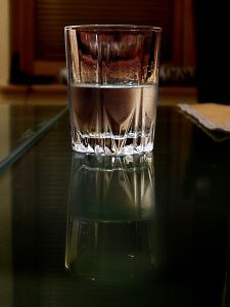

Fine shochu is a primo drinking experience. Photo by Juri Staikov | SXC.
KAREN HOCHMAN is Editorial Director of THE NIBBLE.
|
August 2010 |
 |
Shochu
Page 1: Meet The “White Liquor” Of Japan
An overview of shochu, pronounced show-CHEW, a distilled, clear, neutral-grain spirit from Japan. The artisan brand Haamonii is smooth as silk, with no burn and a delicious flavor. Shochu has about one-third the calories of vodka, gin, rum and whiskey—a calorie bargain. While it is little known internationally, on a volume basis, shochu is the second-most consumed spirit in the world, after Chinese bak jau. This is Page 1 of a three-page article. Click on the black links below to visit the other pages.
Shochu Overview
Do you know shochu? Like vodka, it’s a grain neutral spirit—in this case, distilled from various starches including barley, brown sugar, buckwheat, rice or sweet potatoes, instead of the potatoes, wheat or rye most often used for vodka. Like vodka, it isn’t aged, and thus it can be infused with a variety of flavors.
There are two main categories of shochu.
- Otsurui shochu is distilled just once. This is the older method, a technique dating back to the 14th century. With only one distillation, the source ingredient provides its own very distinct flavor and aroma profile to the shochu: from smooth and light flavor of rice shochu to the strong, earthy, peaty flavor of sweet potato shochu. Otsurui shochu is enjoyed straight or on the rocks.
- Korui shochu is distilled several times, a technique that originated to create a more neutral spirit. Lighter, cleaner and more versatile, it is a favorite in mixed drinks.
- Soju. Soju is a similar spirit from Korea, shochu is from Japan. Recently the two terms have been used interchangeably.
Distilled beverages were used primarily used for medicinal purposes. Abu Musa Jabir ibn Hayyan (721-815 C.E.), considered the “father of chemistry,” invented the alembic still and retort plus distilled alcohol. (He also established the perfumery industry.) He is believed to be of Persian nationality. The spirits he distilled were used as medicines as early as the 8th century, and the process spread throughout the world in the 9th century.
As distillation spread north to Europe and east through Asia, the ancestor of shochu traveled from Persia, east to China, India, Korea and Thailand, then to Okinawa, Japan. From there it reached Kagoshima, a city on the southwestern tip of Japan. There, the technique of making what would be called shochu was refined. The climate is too hot for saké brewing, so it became the shochu capital: Shochu was the only alcohol made there. First used as a medicine, over centuries it became the drink of the working class.
Shochu is even more popular in Japan than saké: It recently has surpassed saké consumption in Japan for the first time in history. In the past few years, shochu bars have appeared on the scene. According to ShochuCircle.com, some carry as many as 3,200 different shochus. Shochu cocktails-in-a-can are ubiquitous in vending machines, subway kiosks and convenience stores.
How Does Shochu Differ From Other Spirits?
Shochu:
- Is Lower In Alcohol Than Most Spirits. By law, the alcohol content of shochu must be 45% or less. Shochu typically contains 25% to 35% alcohol by volume (that’s 50-75 proof—weaker than the 80 proof/40% alcohol that is typical of vodka and other spirits). Lower alcohol also means fewer calories: 15-20 calories per ounce as opposed to 64 calories per ounce for vodka, rum, gin and whiskey.
- It Has More Kick Than Saké. Saké, by comparison, starts at about 12% alcohol/24 proof, although it can be brewed as high as 20% alcohol/40 proof. (See our Saké Glossary).
- It Has More Alcohol Than Rice Wine. Rice wine averages between 18% and 25% alcohol (this is higher than wine from grapes, which are 10% to 15% alcohol and up to 20% alcohol for late-harvest wines and fortified wines such as Port).
In terms of technique: shochu is distilled, saké and beer are brewed and rice wine is fermented.
Beer, the lowest-proof alcoholic beverage, starts around 3.5% but can go to 10% for an imperial stout (and specialty beers can be brewed to a much higher proof). See our Beer Glossary.
Continue To Page 2: Haamonii Ultra Premium Shochu
Go To The Article Index Above
Lifestyle Direct, Inc. All rights reserved. Images are the copyright of their individual owners.

|